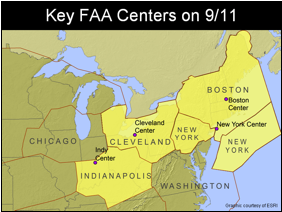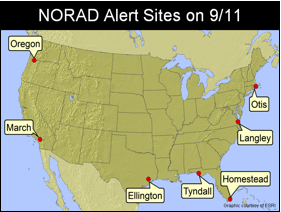On 9/11 the defense of U.S. air space depended on close interaction between two federal agencies: the FAA and the North American Aerospace Defense Command (NORAD). The last hijacking that involved U.S. air traffic controllers, FAA management, and military coordination, had occurred in 1993. In order to understand how the two agencies interacted eight years later, we will review their missions, command-and-control structures, and working relationship on the morning of 9/11.
1.1 FAA Mission and Structure
As of September 11, 2001, the FAA was mandated by law to regulate the safety and security of civil aviation. The purpose of its prescribed air traffic control responsibilities [was], and remains, to minimize the risk of aircraft collisions while maximizing the capacity and efficiency of air transport. To carry out its mission, the FAA utilized 22 Air Route Traffic Control Centers, nearly 26,000 operational air traffic controllers, over 400 air traffic control towers, 195 terminal radar approach control facilities, and over 34,000 system elements for surveillance, communications, navigation and landing aids, and weather sensing.[i]
The primary job of Air Traffic Controllers is to maintain mandatory minimum separation between aircraft. When an airplane takes off, it reports to controllers sitting in airport control tower facilities. At major metropolitan airports the tower controllers pass control quickly to short range (but higher resolution) radar control facilities known as Terminal Radar Approach Controls (TRACONs). Once an aircraft is approximately 30 miles from its point of departure, TRACON controllers “hand off” the aircraft and its transponder tracking signal to the corresponding Traffic Control Center whose airspace the aircraft will enter next.
These Traffic Control Centers are grouped together under seven regional facilities that help manage and oversee operations within their airspace. They also operate in close coordination with the Air Traffic Control System Command Center, commonly referred to as the “Command Center.” The Command Center is located in Herndon, Virginia. Its primary responsibility is to oversee day-to-day operations within the entire airspace system, to keep traffic levels manageable for controllers working at the en-route centers.
In the FAA chain of command, the regional facilities report to FAA headquarters in Washington, DC. It is responsible for the management, operation and overall safety of the National Air System. A Washington Operations Center located at FAA headquarters receives notifications from the en route centers and the regions of incidents affecting the National Air System, including accidents and hijackings.
 FAA Centers often receive information and make operational decisions independent of one another. On 9/11, the four hijacked aircraft were monitored mainly by four of these FAA Air Route Traffic Control Centers, based in Boston, New York, Cleveland, and Indianapolis. Each Center thus had part of the knowledge of what was going on across the system. But it is important to remember that what Boston Center knew was not necessarily known by the Centers in New York, Cleveland, or Indianapolis.
FAA Centers often receive information and make operational decisions independent of one another. On 9/11, the four hijacked aircraft were monitored mainly by four of these FAA Air Route Traffic Control Centers, based in Boston, New York, Cleveland, and Indianapolis. Each Center thus had part of the knowledge of what was going on across the system. But it is important to remember that what Boston Center knew was not necessarily known by the Centers in New York, Cleveland, or Indianapolis.
Controllers track airliners like the four aircraft hijacked on 9/11 primarily by watching the data from a signal emitted by the aircraft’s transponder equipment. The four aircraft hijacked on 9/11, like all aircraft traveling above 10,000 feet, were required to emit a unique transponder signal while in flight.[ii]
On 9/11, the terrorists turned off the transponders on three of the four hijacked aircraft.
With the transponder turned off, it may be possible, although more difficult, to track an aircraft by its primary radar returns. A primary radar return occurs when the signal sent from a radar site bounces off an object in the sky and indicates the presence of that object. But primary radar returns do not include the transponder data, which show the aircraft’s identity and altitude. Controllers at Centers rely on transponder signals and usually do not display primary radar returns on their scopes. But they can change the configuration of their radar scopes so they can see primary radar returns. In fact, the controllers did just that on 9/11 when the transponders were turned off in three of the four hijacked aircraft. Tower or terminal approach controllers handle a wider variety of lower-flying aircraft; they often use primary radar returns as well as transponder signals.[iii]
This overview of the FAA’s organizational structure and how the FAA tracks aircraft within the NAS provides [part of] the framework for our findings concerning the operational facts of 9/11. The framework for a clear understanding of the operational facts is incomplete[, however,] without an overview of the command structure, mission and posture of NORAD as it existed on 9/11.
1.2 NORAD Mission and Structure
NORAD was, and is, responsible for the air defense of the continental United States. On 9/11, NORAD’s air defense mission was to “destroy, nullify, or reduce the effectiveness of attacking enemy aircraft or missiles” by providing “Total Force Air Defense and threat warning to North America through readiness, detection and identification, and if necessary, force application.”
To perform its air defense mission, NORAD consists of three regions: Alaskan NORAD Region (ANR), Canadian NORAD Region (CANR), and the Continental U.S. NORAD Region (CONR). CONR is further broken into three sectors: Western Air Defense Sector at McChord AFB, Wash.; Northeast Air Defense Sector at Rome, N.Y.; and Southeast Air Defense Sector at Tyndall AFB, Fla., which is also the headquarters for CONR. In the deployment of U.S. air defense assets, the Sectors report to CONR, and CONR reports to NORAD Headquarters, located in Colorado Springs, CO.
 On 9/11, NORAD’s continental U.S. (CONUS) air defense posture included 7 alert bases and 14 alert fighter aircraft. Each base had 2 fighter aircraft on alert. Alert aircraft were under the tactical control of the three regional sectors. NEADS, the sector that responded to all four hijacked aircraft on 9/11, had 2 alert bases and 4 alert fighter aircraft under [its] tactical control – two F-15s from the Otis Air National Guard Base in Cape Cop, Massachusetts and two F‑16s from the Langley Air Force Base in Langley, Virginia.[iv]
On 9/11, NORAD’s continental U.S. (CONUS) air defense posture included 7 alert bases and 14 alert fighter aircraft. Each base had 2 fighter aircraft on alert. Alert aircraft were under the tactical control of the three regional sectors. NEADS, the sector that responded to all four hijacked aircraft on 9/11, had 2 alert bases and 4 alert fighter aircraft under [its] tactical control – two F-15s from the Otis Air National Guard Base in Cape Cop, Massachusetts and two F‑16s from the Langley Air Force Base in Langley, Virginia.[iv]
The key decisions in the nation’s immediate air defense response to the 9/11 attacks were made by the military personnel at NEADS. NEADS conducts operations from a Sector Operations Command Center (“SOCC”). In normal day to day operations, the SOCC is led by a Mission Crew Commander (“MCC”). The MCC monitors the SOCC floor, receives reports from numerous watch-standers manning radar consoles, and makes tactical decisions based on those reports. Normally, the MCC also directs the updating of CONR and NORAD Headquarters through a secure computer terminal communication called a “chat log.” During exercises or real-world operations, a Battle Commander assumes the highest authority at NEADS, oversees the MCC and the SOCC, and communicates directly with the Commander at CONR.
CONR is responsible for coordinating the sector commands and the air defense for CONUS. The CONR Region Commander is the highest ranking military authority at CONR, and reports to NORAD. On 9/11, the operations center at CONR was called the Regional Air Operations Center (RAOC). The highest authority at CONR is the CONR Battle Commander (CONR BC). On 9/11, the RAOC floor, unlike sector operations centers, did not utilize radar scopes, or any direct-feed radar data from the FAA or NORAD radar sites. Instead, it used computer terminals to display manually entered tracks, and communicated with the Sectors by both secure and unsecure phone lines and various computer-based chat logs.
NORAD Headquarters (HQ) exercises command authority over NEADS via CONR. NORAD HQ operations are run from the Cheyenne Mountain Operations Center (CMOC) which is located in Cheyenne Mountain, Colorado. NORAD’s Command Director runs the CMOC and is responsible for deciding the appropriate level of response from NORAD assets, and for communicating with the National Military Command Center (NMCC) which is located at the Pentagon. CMOC did not possess direct radar picture feeds from either FAA or NORAD radar facilities.
« Previous Section | Table of Contents | Next Section »
[i] FAA report, “Administrator’s Fact Book,” July 2001; Ben Sliney interview (May 21, 2004); John McCartney interview (December 17, 2003).
[ii] FAA regulations, Air Traffic Control transponder and altitude reporting equipment and use, 14 CFR 91.215 (2001).
[iii] DOD radar files, 84th Radar Evaluation Squadron, “9/11 Autoplay,” undated; Charles Thomas interview (May 4, 2004); John Thomas interview (May 4, 2004); Joseph Cooper interview (Sept. 22, 2003); Tim Spence interview (Sept. 30, 2003). For general information on approaching terminals, see FAA report, “Aeronautical Information Manual,” Feb. 19, 2004. Times assigned to audio transmissions were derived by the Commission from files provided by the FAA and the Northeast Air Defense Sector (NEADS) based on audio time stamps contained within the files provided by the sender. FAA tapes are certified accurate to Universal Coordinated Time by quality assurance specialists at FAA air traffic facilities. NEADS files are time-stamped as accurate to the Naval Observatory clock. Staff also compared audio times to certified transcripts when available.
[iv] Donald Quenneville interview (Jan. 7, 2004); Langley Air Force Base 119th Fighter Wing briefing (Oct. 6-7, 2003).


No responses yet